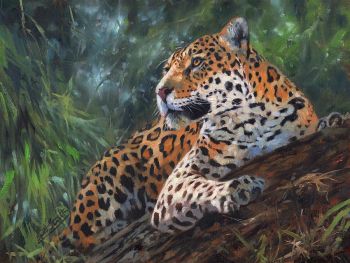Jaguar
| Species | feline |
| No. Appearing | 1–4 |
| Behaviour | presocial |
| Range | alpine, desert, jungle, savanna |
| Size | 4 ft. 9 in. long |
| Weight | 168 lbs. |
| Intelligence | 2 |
| Armour Class | 6 |
| Hit Dice | 4+1 |
| Action Points | 6 |
| Max. Stride | 20 |
| THAC0 | 18 |
| Hp/Die | d8 |
| Attack Forms | 3: two claw; fangs |
| Damage | claw (2–8); fangs (4–16) |
| Special Attacks | pounce, raking, surprise on a 1–3, surprised only on a 1 |
Jaguars are large members of the cat family that inhabit a broad range of climates from Mexico to northern Argentina. They may be found in rainforests, savanna and jungle, thriving especially well in the last. Despite bearing spots reminiscent of a leopard, jaguars distinguish themselves by their larger, more robust build. Some jaguars sport entirely black coats, while albino variations, known as white panthers, exist but are exceptionally rare.
Contents
Their presence in certain areas can pose challenges for livestock farmers as jaguars might prey on cattle or other domestic animals. This can lead to conflicts and economic losses for the farmers.
Behaviour
Jaguars are solitary and territorial predators, prowling at night to ambush their prey. Not confined to land, they possess remarkable swimming skills, navigating rivers with ease. Their diverse diet include caymans, deer and fish, preferring to hunt and live alone. They establish large home ranges, marking their territory with urine, feces and claw marks on trees, which can be recognised by characters familiar with the feline.
They use body language, vocalizations like roars, growls and even hisses to communicate with other jaguars or to establish dominance in their territory. As powerful, apex predators, their actions are often shaped by threats to their food source or the need to maintain their hunting ground.
On average, jaguars typically consume around 3 lbs. of meat daily. However, due to uncertain hunting opportunities, they can gorge themselves upon 55 lbs. of meat during a single feeding. They engage in mating but do not form familial units. Encountering a single jaguar often indicates a solitary male or female, with the former being more prevalent. When two or more jaguars are spotted, it's likely to be a female accompanied by her cubs. Rarely observed are mated pairs together, as their mating period lasts only a few days. Mating can take place at any time throughout the year.
Advantages
Pounce. Large cats exert considerable force when they pounce, using their weight and muscular power to knock down their prey. At the start of a combat, the jaguar springs forward a distance of 10 to 15 feet following a swift approach, or descends on prey from above. Should the jaguar catch its target off guard — either with surprise or initiative — this pounce inflicts 1-6 damage in addition to that caused by its normal attacks.
- Additionally, the defender is knocked prone, though not stunned, unless the jaguar's attacks cause sufficient damage. In such cases, the character must expend 2 extra action points fending off and freeing themselves from the jaguar's attack before fighting back or regaining their feet. Pouncing can be employed only once per combat.
Raking. When the jaguar strikes successfully with both its front claws, it gains two extra raking hits with its rear claws. This reflexive damage is applied without the need of a to hit roll, landing on the target that took the most damage from either or both claws — or randomly determined if need be.
Advantages
Jaguars can climb trees very skillfully, often resting on tree branches and descending from trees headfirst. When a jaguar attacks, at the end of its rush it will leap four combat hexes following its movement, enabling it to close the distance quickly with its prey. It is able to perform this leap between trees, prior to dropping down on and surprising opponents from an initial, hidden location.
The jaguar attacks with their claws and fangs. If the jaguar strikes with both forepaws, it will then get two additional attacks, raking with the rear claws, each causing 1-10 damage.
The jaguar is very observant in its habitat and possesses an excellent sense of smell; it can be surprised only on a 1 in 6.
See Bestiary
